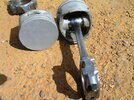CMF_economy_guy
» CMF MemberHi, I just joined up because I'm thinking about buying a K11 Micra (basically from the point of an ultimate low cost commuter vehicle - I need a new car). To give a bit of background, fuel economy has been an obsession of mine over the last few years.
With the new purchase I'm basically trying to optimize lowest total costs per year.
I'm leaning towards a Micra. I'd consider maybe a Daihatsu Charade Centro as an alternative (or at most a Starlet, the 1998 Prius is a bit too expensive for now for the amount I'd save even in a worst case scenario of more driving and $4/l petrol), but there are several factors that sway me in the direction of the Nissan, notably the timing chain not having to be replaced every few years (as the timing belt would need to be), the engine being bigger would probably last longer. The K11 is reputed to have good build quality and not many issues with regards to maintenance. Also the enthusiast community is far larger, there is a Haynes manual, etc.
I've done my searching the forums to find the answers, but I can't find them so I'm asking here.
1. Does anyone know the drag coefficient of the Micra? I can't find this anywhere. I suspect it would be somewhere between 0.33 and 0.37, but would like to get a more accurate figure.
2. Has anyone here beat the specification highway figure of 4.4l/100km? By what? Any hypermilers here? From browsing the forum few people seem to do better than 6l/100km.
3. What is the lowest rpm @ 100km/hr figure someone here has achieved through changed gearing or larger tyres, and how did they do it? How much did it cost, and were there any downsides? How much did the fuel economy change?
That's basically it. If anyone has any questions on fuel economy or how to improve it (driving or modifications), I'll do my best to answer. It has been my hobby for several years now and my background is engineering.
With the new purchase I'm basically trying to optimize lowest total costs per year.
I'm leaning towards a Micra. I'd consider maybe a Daihatsu Charade Centro as an alternative (or at most a Starlet, the 1998 Prius is a bit too expensive for now for the amount I'd save even in a worst case scenario of more driving and $4/l petrol), but there are several factors that sway me in the direction of the Nissan, notably the timing chain not having to be replaced every few years (as the timing belt would need to be), the engine being bigger would probably last longer. The K11 is reputed to have good build quality and not many issues with regards to maintenance. Also the enthusiast community is far larger, there is a Haynes manual, etc.
I've done my searching the forums to find the answers, but I can't find them so I'm asking here.
1. Does anyone know the drag coefficient of the Micra? I can't find this anywhere. I suspect it would be somewhere between 0.33 and 0.37, but would like to get a more accurate figure.
2. Has anyone here beat the specification highway figure of 4.4l/100km? By what? Any hypermilers here? From browsing the forum few people seem to do better than 6l/100km.
3. What is the lowest rpm @ 100km/hr figure someone here has achieved through changed gearing or larger tyres, and how did they do it? How much did it cost, and were there any downsides? How much did the fuel economy change?
That's basically it. If anyone has any questions on fuel economy or how to improve it (driving or modifications), I'll do my best to answer. It has been my hobby for several years now and my background is engineering.




